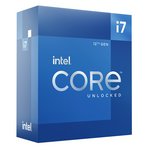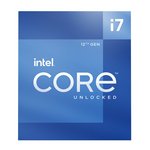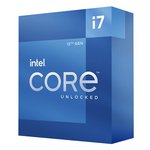Intel Core i7-12700K Alder Lake
CPUProduct Gallery



Product Overview
Intel Core i7-12700K is a premium desktop microprocessor based on Intel's 12th-gen Core Alder Lake architecture. Like the i5-12600K and i9-12900K unveiled at the same time, the i7-12700K features a new "hybrid" design, in this case with 8 performance cores and 4 efficiency cores.
With this hybrid design, Intel is able to offer a significant performance boost over the 11th-gen chips (notably the i7-11700K). At the same time, the move to the Intel 7 (10nm) process affords the i7-12700K more leeway in turbo performance: the CPU is able to stay at boost clock significantly longer than before, though it still consumes a lot of electricity while doing so.
The inclusion of efficiency cores, meanwhile, allows Intel to do away with "TDP down" mode: in situations where this were called for, the CPU simply runs the efficiency cores instead.
Other notable highlights include support for PCIe 5 and DDR5 memory, though compatible components remain rare and expensive.
Those who intend on installing their own discrete graphics card can opt for the i7-12700KF, which drops the integrated UHD 770 graphics but is otherwise identical.
Ratings
What we found
Neofiliac score 72%
Pros
- 12 cores / 20 threads
- Supports DDR5 memory
- ECC memory
- Has integrated graphics
- PCIe 5.0 support
Cons
What external reviewers found
External score 74%
Pros
- Improved single-threaded performance
- Supports PCIe 3.0 and x8 DMI 4.0
- Improved connectivity options
- New E-Cores
- DDR5 and DDR5 DIMMs available in all price bands
Cons
- No integrated graphics
- Higher latency than DDR4
- Higher price than Core i9-12700K
Your rating:
12345678910
?/10
Price Comparison
As associates of the merchants above, we earn a commission when you make a purchase using the supplied links.
Specifications
[{"Ft":"Connectivity","Fn":"CPU Socket","Fv":"FCLGA1700"},{"Ft":"Connectivity","Fn":"PCI Express","Fv":"5.0 and 4.0, 20 lanes (Up to 1x16+4, 2x8+4)"},{"Ft":"Connectivity","Fn":"Ports","Fv":"eDP 1.4b, DP 1.4a, HDMI 2.1"},{"Ft":"Construction","Fn":"Form Factor","Fv":"Desktop microprocessor Box"},{"Ft":"Construction","Fn":"Lithography","Fv":"Intel 7"},{"Ft":"Construction","Fn":"Platform","Fv":"Alder Lake"},{"Ft":"Dimensions","Fn":"Size | Depth","Fv":"37.5 mm"},{"Ft":"Dimensions","Fn":"Size | Width","Fv":"45.0 mm"},{"Ft":"Function","Fn":"Graphics","Fv":"Intel® UHD Graphics 770, 32 execution units, Base 300 MHz, Boost 1.50 GHz, Max 4 displays, DirectX 12, OpenGL 4.5, OpenCL 3.0"},{"Ft":"Function","Fn":"Operating Temperature","Fv":"Max Tjunction 100°C"},{"Ft":"Function","Fn":"Processor | Cores","Fv":"12 Cores (8 performance cores / 4 efficient cores)"},{"Ft":"Function","Fn":"Processor | Threads","Fv":"20 Threads"},{"Ft":"Function","Fn":"Resolution","Fv":"Max res DP 7680 x 4320 @ 60Hz / Max res HDMI 4096 x 2160 @ 60Hz"},{"Ft":"Function","Fn":"Security","Fv":"vPro Enterprise, Threat Detection Technology (TDT), Active Management Technology (AMT), Standard Manageability (ISM), One-Click Recovery, Hardware Shield Eligibility, Control-Flow Enforcement Technology, Total Memory Encryption - Multi Key, Total Memor..."},{"Ft":"Function","Fn":"Supported Technologies","Fv":"Gaussian \u0026amp;amp; Neural Accelerator 3.0, Thread Director, Deep Learning Boost (Intel DL Boost), Optane™ Memory Supported, Speed Shift Technology, Turbo Boost Max Technology 3.0, Hyper-Threading Technology, Enhanced Intel SpeedStep Technology, Thermal..."},{"Ft":"Function","Fn":"Thermal Solution","Fv":"PCG 2020A"},{"Ft":"Function","Fn":"Video","Fv":"Clear Video HD Technology"},{"Ft":"Performance","Fn":"Cache","Fv":"25 MB Intel® Smart Cache12 MB L2"},{"Ft":"Performance","Fn":"Frequency","Fv":"Max Turbo: 5.00 GHz(Max P-core: 4.90 GHz / Max E-core: 3.80 GHz) | (Base P-core: 3.60 GHz / Base E-core: 3.60 GHz)"},{"Ft":"Performance","Fn":"Memory | Capacity","Fv":"Supports up to 128 GB"},{"Ft":"Performance","Fn":"Memory | Type","Fv":"Up to DDR5 4800 MT/s, Up to DDR4 3200 MT/s, Max 2 channels, ECC supported, Max bandwidth 76.8 GB/s"},{"Ft":"Performance","Fn":"Power Consumption","Fv":"125 W Base / 190 W Turbo"},{"Ft":"Production","Fn":"Debut","Fv":"2021 Q4"},{"Ft":"Production","Fn":"Model Name","Fv":"i7-12700K"}]
External Reviews
pcmag[1]
Reviewer score 71% (normalized by Neofiliac)The Core i7-12700K is faster than its 11th Generation predecessor, but the degree to which performance has increased is rather impressive. It’s not quite as powerful as the Core i9-12900K for CPU-intensive tasks, and its performance gains aren’t substantial enough purely for gaming to recommend it. The Core i5-12600K might be a better option for a pure gaming build.
Pros
- Improved single-threaded performance
- New E-Cores
Cons
- Higher price than Core i9-12700K
- No integrated graphics
tomshardware[2]
Reviewer score 77% (normalized by Neofiliac)The standard Core i7-12700K comes with the UHD Graphics 770 with 32 EUs that run at a 300 / 1500 MHz base/boost. You will lose Quick Sync capabilities and the iGPU fallback that you can use for troubleshooting in the event of an issue with a discrete graphics card. Intel's Alder Lake drops into Socket 1700 motherboards with the Z690 chipset.
Pros
- DDR5 and DDR5 DIMMs available in all price bands
- Supports PCIe 3.0 and x8 DMI 4.0
- Improved connectivity options
Cons
- Higher latency than DDR4
References
<
>
x